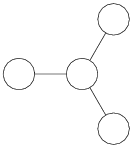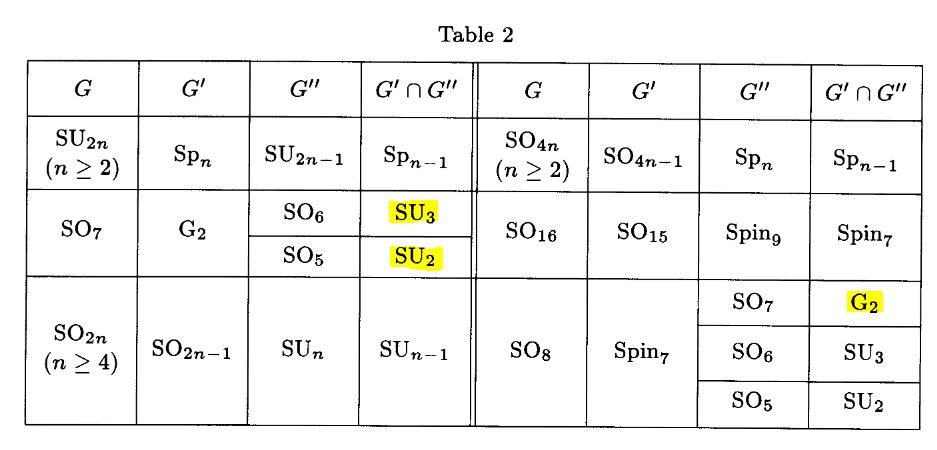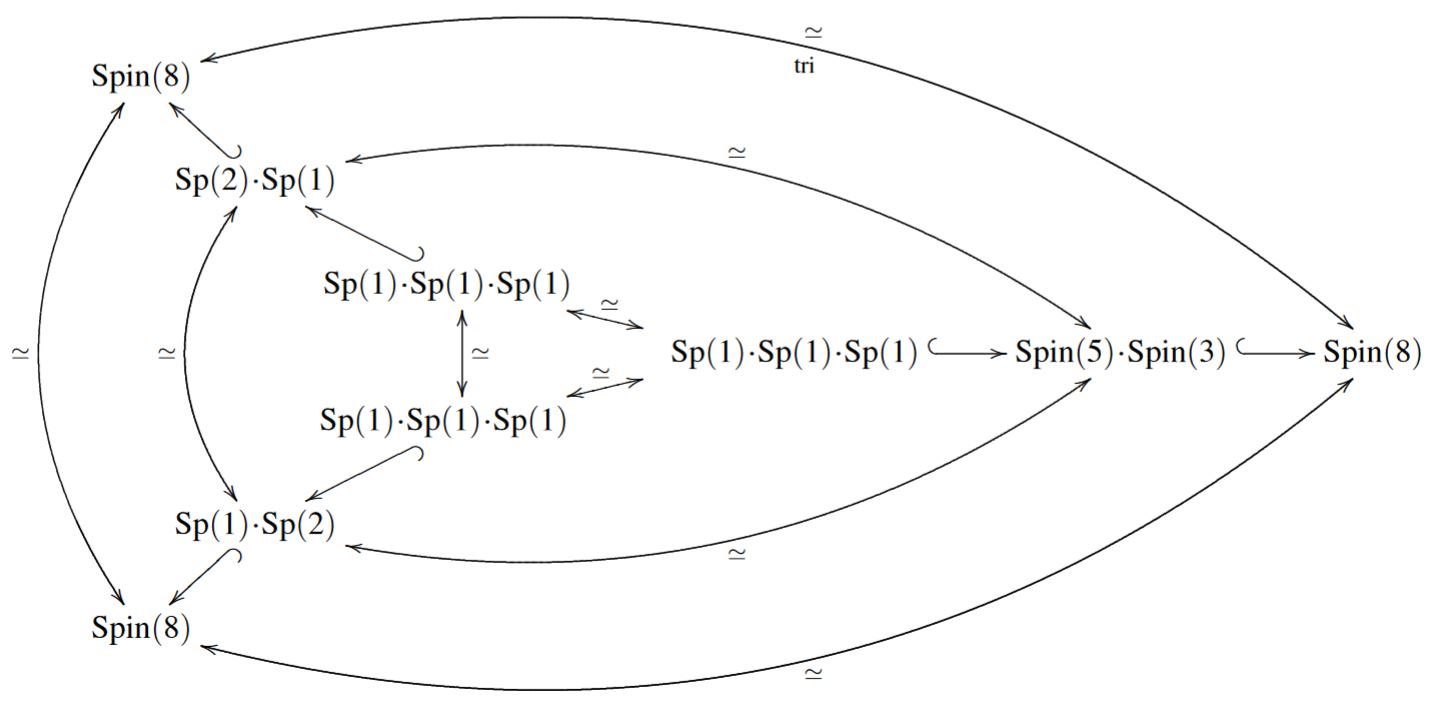nLab triality
Contents
Idea

The Dynkin diagram/Dynkin quiver D4 has an S3-symmetry group
(graphics grabbed from Wikipedia here)
This manifests itself in “triality” symmetries enjoyed by the objects that are labeled by D4 in an ADE-classification.
Specifically for the simple Lie group SO(8) corresponding to D4, triality is the statement that the two spin representations of the corresponding spin group and the defining vector representations are all isomorphic, and in a nice way.
Details
Triality of subgroups of and
Proposition
(Spin(7)-subgroups in Spin(8))
There are precisely 3 conjugacy classes of Spin(7)-subgroups inside Spin(8), and the triality group acts transitively on these three classes.
(Varadarajan 01, Theorem 5 on p. 6, see also Kollross 02, Prop. 3.3 (1))
Proposition
(G₂ is intersection of Spin(7)-subgroups of Spin(8))
The intersection inside Spin(8) of any two Spin(7)-subgroups from distinct conjugacy classes of subgroups (according to Prop. ) is the exceptional Lie group G₂, hence we have pullback squares of the form
(Varadarajan 01, Theorem 5 on p. 13)
Proposition
We have the following commuting diagram of subgroup inclusions, where each square exhibits a pullback/fiber product, hence an intersection of subgroups:
Here in the bottom row we have the Lie groups
Spin(5) Spin(6) Spin(7) Spin(8)
with their canonical subgroup-inclusions, while in the top row we have
and the right vertical inclusion is the delooping of one of the two non-standard inclusions, according to Prop. .
Proof
The square on the right is that from Prop. .
The square in the middle is Varadarajan 01, Lemma 9 on p. 10.
The statement also follows with Onishchik 93, Table 2, p. 144:

Proposition
(Spin(5).Spin(3)-subgroups in SO(8))
The direct product group SO(3) SO(5) together with the groups Sp(2).Sp(1) and , with their canonical inclusions into SO(8), form 3 conjugacy classes of subgroups inside SO(8), and the triality group acts transitively on these three classes.
Similarly:
Proposition
(Spin(5).Spin(3)-subgroups in Spin(8))
The groups Spin(5).Spin(3), Sp(2).Sp(1) and , with their canonical inclusions into Spin(8), form 3 conjugacy classes of subgroups inside Spin(8), and the triality group acts transitively on these three classes.
In summary we have these subgroup inclusions
permuted by triality:

graphics grabbed from FSS 19, Sec. 3.3
References
General
- Tonny Springer, Ferdinand Veldkamp, chapter 3 of Octonions, Jordan Algebras, and Exceptional Groups, Springer Monographs in Mathematics, 2000
Discussion of triality of subgroups of Spin(8) and SO(8):
-
Veeravalli Varadarajan, Spin(7)-subgroups of SO(8) and Spin(8), Expositiones Mathematicae Volume 19, Issue 2, 2001, Pages 163-177 (doi:10.1016/S0723-0869(01)80027-X, pdf)
-
Martin Čadek, Jiří Vanžura, On and -structures in 8-dimensional vector bundles, Publicacions Matemàtiques Vol. 41, No. 2 (1997), pp. 383-401 (jstor:43737249)
-
Megan M. Kerr, New examples of homogeneous Einstein metrics, Michigan Math. J. Volume 45, Issue 1 (1998), 115-134 (euclid:1030132086)
-
Andreas Kollross, Prop. 3.3 of A Classification of Hyperpolar and Cohomogeneity One Actions, Transactions of the American Mathematical Society Vol. 354, No. 2 (Feb., 2002), pp. 571-612 (jstor:2693761)
See also
-
Wikipedia, Triality
In string theory
Exposition with an eye to application in string theory:
- David Tong, Carl Turner, Notes on 8 Majorana Fermions (arXiv:1906.07199)
Discussion in the foundations of M-theory:
Last revised on July 18, 2024 at 13:05:04. See the history of this page for a list of all contributions to it.